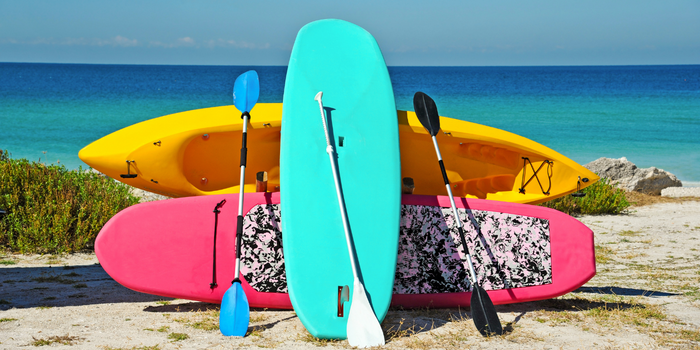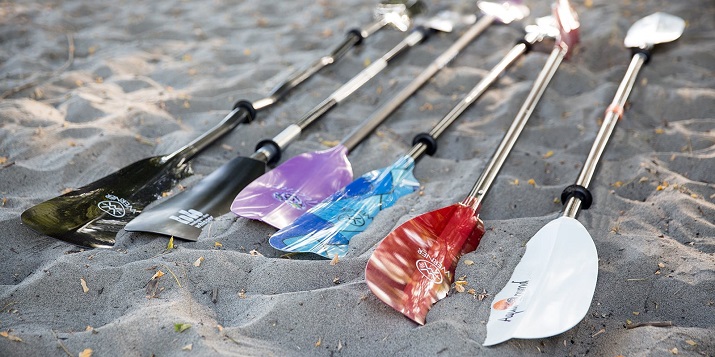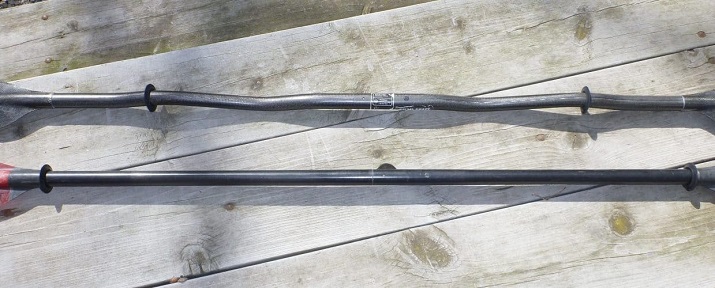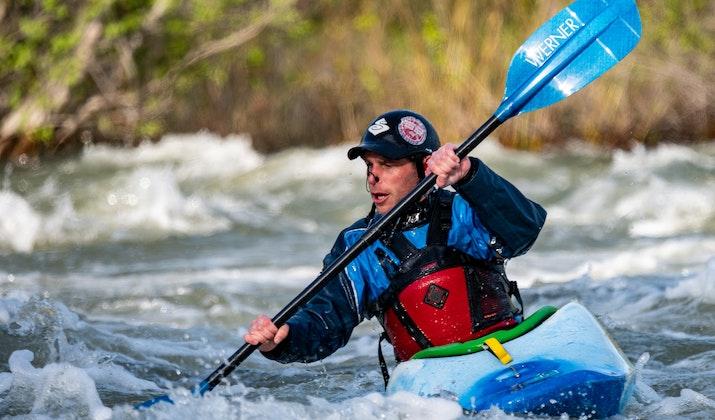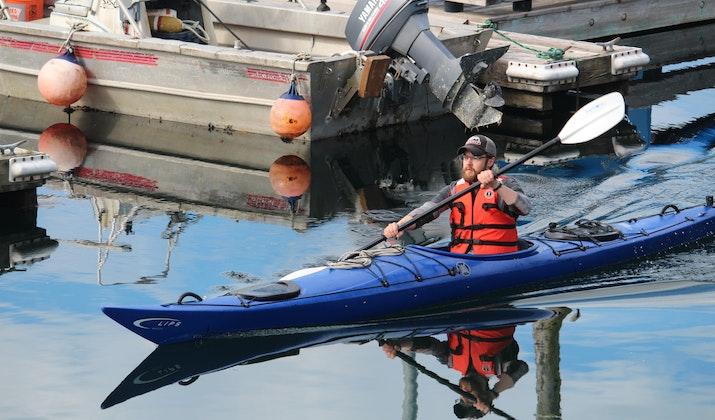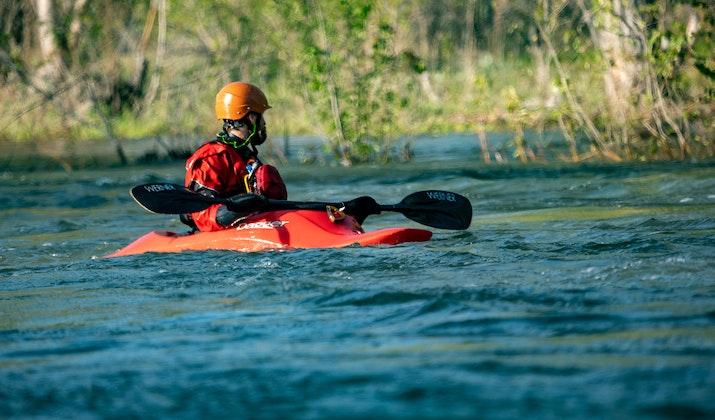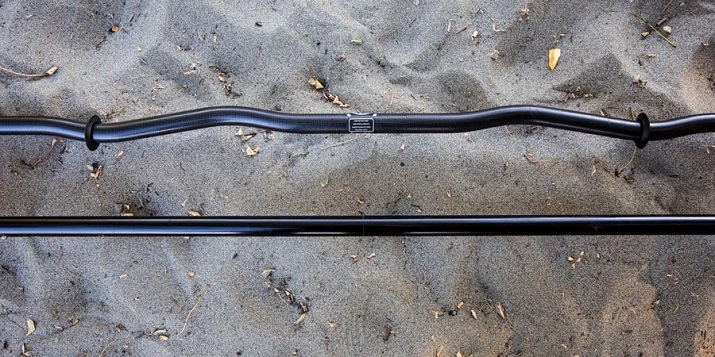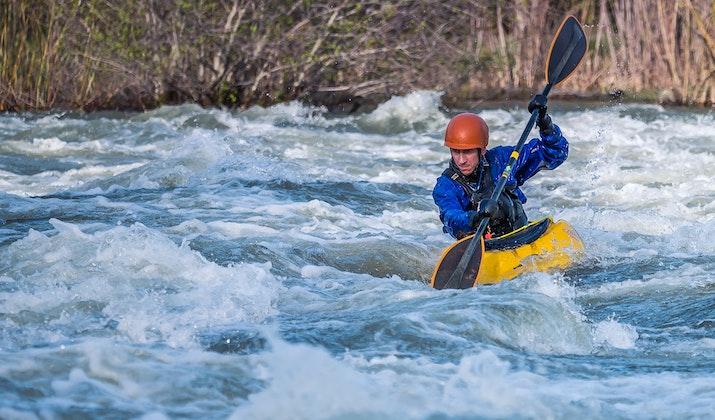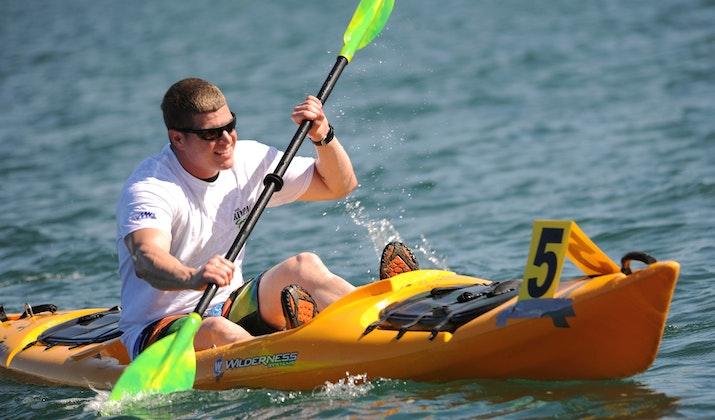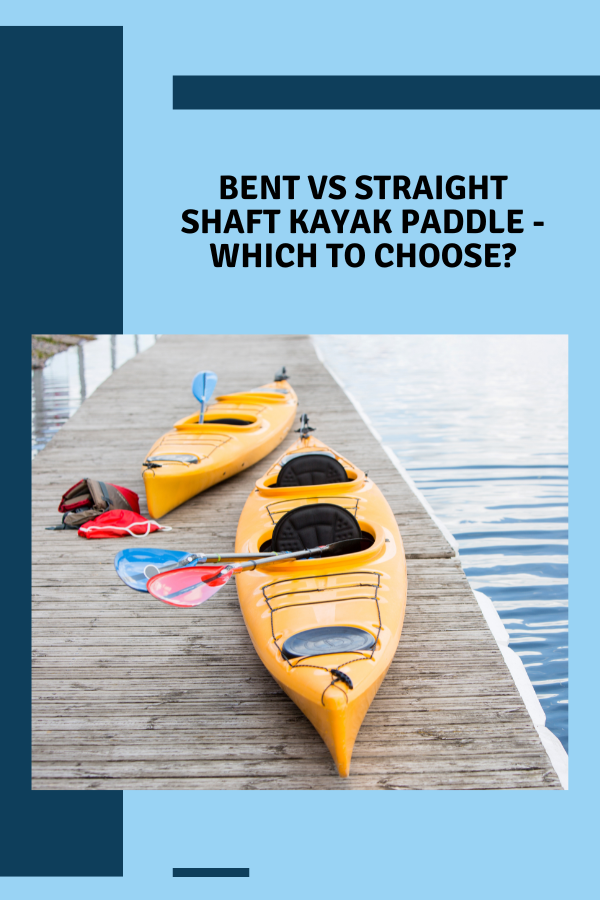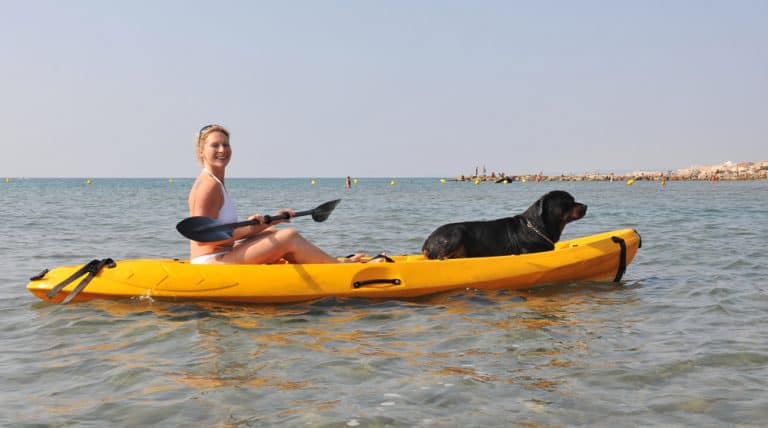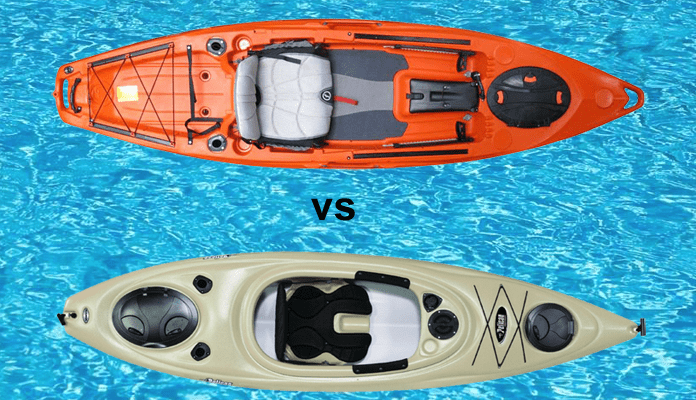Whether you’re browsing through kayak paddle designs online and wondering which one to buy or you’re thinking about renting a kayak and wondering which one is best for you, you are going to be offered plenty of straight shaft and bent shaft paddle designs to choose from.
If you don’t know the difference between these two types of paddle shaft design or the advantages and disadvantages that each one can offer you, you may end up with a kayak paddle that doesn’t work for you.
In this post, I’m going to break down the features and functionalities that set bent and straight shaft kayak paddles apart.
By the end, you will be able to make an informed decision about which paddle shaft to buy or rent.
Photo by REI
What is a Bent Shaft Kayak Paddle?
A bent shaft paddle””also known as crank shaft or ergo shaft paddle”” has a bend at the neck or throat of the paddle””the point where the blade meets the shaft””that allows you to extend your reach and maximize forward strokes when paddling your kayak.
Bent shaft paddles are usually bent at the throat at a 7° to 15° angle. It’s important to take note of the degree of the main bend because if you end up with a bent shaft paddle that veers outside of these parameters, it will not deliver any serious advantage over a straight paddle.
This means that you would miss out on the entire point of getting a bent shaft kayak paddle in the first place: more power, speed, and better control.
In addition to the bend at the neck of the paddle, some bent shaft designs also feature extra bends along the length of the shaft to lessen the impact on the joints for kayakers with shoulder problems.
Paddlers who prefer to only stroke on one side of their kayak may also benefit from the greater ease provided by these double bend shafts.
However, if you don’t belong to these categories and you want greater efficiency and the ability to easily switch sides when paddling or racing in your kayak, you’re always better off with the regular single-bend bent shaft paddles.
What is a Straight Shaft Kayak Paddle?
Photo by Brett Sayles
As the name implies, this type of kayak paddle features a straight shaft, rather than a curved or bent one. Straight shaft kayak paddles are the traditional or standard shape that most kayak paddles come in.
The entire length of the paddles is usually 100% straight from blade to blade. Since most paddlers have used straight shaft paddles at one point or the other, especially when they were at the beginning of their kayaking journey, they tend to have a familiar feel.
Straight shaft paddles are also typically lighter and less expensive than their bent counterparts.
Bent Shaft vs Straight Shaft Kayak Paddle – Use Cases
Before choosing which type of shaft design to go for when buying a kayak paddle, you need to consider what purpose you will be using it for because both bent shaft and straight shaft paddles each have unique benefits and motives that they are best suited to.
Let’s find out when and where it’s advisable to use a straight shaft or bent shaft kayak paddle.
Bent Shaft Kayak Paddle
If you’re an experienced paddler or you are traveling from one point to another on flat water or slow-moving rivers, the efficiency of a bent shaft paddle cannot be beat.
Bent shaft paddles are excellent for multi-day expeditions or long touring trips where you spend many hours on the water. This is because the bend in the paddle shaft offers a more efficient stroke and uses up less energy per stroke.
Also, bent shaft kayak paddles are the preferred and recommended shaft design for performance-minded kayakers who plan to do a lot of cruising, racing, and intense paddling.
People who are prone to experiencing pains and aches in the shoulders, elbow, or wrist regions will deal with less discomfort if they opt for a bent shaft paddle over a straight one.
Bent shaft paddles are ergonomically designed to allow your hands and wrists to rest in a more natural and comfortable position thereby reducing the impact and stress on your ligaments and tendons, and minimizing pain.
So if you tend to hold your paddle too tightly or you enjoy paddling for extended periods or maybe you just want a paddling experience that’s kinder to your body, the bent shaft is the ideal paddle for you.
Photo by Howard Herdi
Straight Shaft Kayak Paddle
If you plan to go whitewater kayaking or explore choppy waters with lots of obstacles that you will need to get around, straight shaft paddles will offer you all the maneuverability you need
Straight shaft paddles allow you to make quick turns in fast flowing waters, making them the ideal paddle for navigating serious rapids.
It’s easier to use a straight shaft paddle to draw, brace, or pry effectively and instantaneously than to use a bent shaft paddle for the same purposes. So in situations where split-second decisions and actions are critical to the survival of both you and your craft, the
People who enjoy recreational paddling, are just kick starting their kayaking journey, or who plan to share tandem kayaks with beginners or young children will find a straight shaft paddle to be easier to use.
Unlike bent shaft paddles that are designed to be paddled with only one face of the blade, straight shaft paddles allow you to use both blade faces.
So you won’t have to worry about which way the blade should be facing because there is no right or wrong option.
Straight Shaft vs Bent Shaft Kayak Paddle – Technical Control
Which paddle gives you better control and reactivity, the bent shaft or the straight shaft paddle?
Straight Shaft Kayak Paddle
When you are using a straight shaft paddle, the start of the paddling stroke will push the water downwards to the bottom of the rivet, which then propels the kayak upward.
The middle of the stroke sends the water rushing towards the kayak’s stern, while the end of the stroke pushes the water up towards the horizon.
This movement of the straight shaft paddle results in the kayak being pulled downward, rather than being pushed forward, giving you more stability and directional control.
It makes it perfect for paddling around obstructions, easily making turns in tight corners, and navigating choppy, fast-flowing waters.
Photo by Spencer Gurley Films
Bent Shaft Kayak Paddle
With a bent shaft paddle, the start of the stroke glides into the water at the same angle as a straight shaft, but then it begins pushing the water backward instead of up or down.
Halfway through the stroke, the bent shaft blade is vertically inclined and it continues to push the water back. By the end of the stroke, it is still efficiently sending the water flowing back towards the stern of the kayak, unlike the straight shaft paddle.
By spending more time pushing water backward towards the stern, the bent shaft paddle is able to maximize forward thrust allowing you to move faster without putting unnecessary strain on your shoulders, elbows, and wrists.
This makes it the better choice for long kayaking trips or paddling races where controlling your forward movement is more important than maneuverability.
Bent Shaft vs Straight Shaft Kayak Paddle – Versatility
Which paddle offers you the most options in terms of strokes you can execute and the adjustments you can make to your paddling style?
Bent Shaft Kayak Paddle
By design, bent shafts minimize the extent to which you need to flex your wrists with forward strokes and just about every other paddling stroke you can think of.
So even if you’re guilty of not properly rotating your torso or of gripping the shaft too tight, you can still paddle however you want without needing a lot of directional correction.
However, the same improvement in wrist positions that makes the bent shaft highly efficient for forward strokes, makes it a hassle in times when you need to back up, brace low, or pry while doing a draw.
Photo by Brett Sayles
Straight Shaft Kayak Paddle
Straight shafts offer more versatility than bent shafts because they allow you to apply a variety of strokes, make quick turns, and adjust your hands to different positions when necessary.
If you go paddling in rough or windy conditions where you may need to extend the reach of the paddle beyond the center of the shaft and still maintain the proper strokes, a straight shaft paddle would easily rise to the occasion, unlike bent shafts that might get in the way.
Straight Shaft vs Bent Shaft Kayak Paddle – Efficiency
How efficient are bent shaft paddles compared to straight shaft paddles? Let’s find out.
Straight Shaft Kayak Paddle
Unlike bent shaft paddles that help you naturally extend your reach and achieve proper wrist alignment in an instant, it takes a long time and a lot of practice to learn these techniques with straight shaft paddles.
However, when it comes to whitewater kayaking and executing tricky maneuvers in rough waters, straight shaft paddles are highly efficient and will do a better job than their bent counterparts.
Photo by Oladapo
Bent Shaft Kayak Paddle
The beauty of a bent shaft paddle is that no matter your paddling style or technique, it’s going to make more efficient use of every stroke by giving it more power and ensuring you still feel great after a long day of paddling rather than feeling fatigued and sore all over.
Although a bent shaft may not perform as well as a straight shaft on whitewater and strong rapids, it will serve you excellently on flatwater, kayak camping trips, long touring expeditions, and whenever you go recreational paddling.
Best Shaft vs Straight Shaft Kayak Paddle – Sizing Method
Photo by REI
Being stuck on water with the wrong paddle length can turn a fun float trip into a harrowing experience regardless of the paddle shaft design you’re using.
The process of sizing bent shaft paddles is the same as sizing straight shaft paddles. There are two common and easy methods that you can use to size your kayak paddle to determine whether it’s the right fit for you before buying or renting it.
The first method uses your torso height as the yardstick for measurement. All you have to do is find a tape measure, place the starting point at the top of your torso where your shoulders meet, then stretch it along the length of your back to the bottom of your torso””the beginning of your hip bone.
Check your measurements against this sizing guide below to figure out the paddle length that will be a good size for you based on whether you prefer or require a high angle or a low angle kayak paddle with your straight or bent shaft paddle design.
| Paddler Torso Height Range | High Angle Kayak Paddle | Low Angle Kayak Paddle |
|---|---|---|
| 24″ – 28″ | 210cm – 215cm | 215cm – 220cm |
| 28″ – 30″ | 220cm – 230cm | 230cm – 240cm |
| Over 30″ | 230cm | Over 230cm |
Straight Shaft vs Bent Shaft Kayak Paddle – Advantages
There are unique benefits that you can enjoy from using a straight shaft or a bent shaft paddle. Knowing the specific advantages that each kayak paddle shaft design offers will help you in figuring out the best option for you.
Bent Shaft Kayak Paddle
- It makes your forward stroke and high braces more effective and efficient, thereby giving you greater control and rotational force and helping paddling feel easier.
- The bend in the paddle helps you keep your hands in the correct position so you can have a more comfortable grip.
- A bent shaft allows you to experience less fatigue, pain, and strain to your upper body and movable joints because it requires you to make better use of your core and less of your arms.
- The bend in the paddle shaft gives you a better inkling of how the blade should be oriented and makes it easier to properly position your paddle when executing a kayak roll, paddling in temperamental waters, or trying out advanced kayaking techniques.
- It’s more kind to the body, especially when used on multi-day paddling trips.
Photo by Brett Sayles
Straight Shaft Kayak Paddle
- It is lighter in weight than a bent shaft paddle by two to three ounces on average.
- It gives you the freedom to change your hand locations as you like to be further or closer apart depending on what the situation calls for, whereas the hand positions on a bent shaft are fixed.
- You get more flexibility with a straight shaft, especially in rough-flowing or wind-influenced waters.
- A straight shaft paddle is typically less expensive than bent shaft paddles and could save you between $100-$150 dollars depending on the brand you go for.
Best Shaft vs Straight Shaft Kayak Paddle – Downsides
Both paddles have their flaws and they can throw a kink in your kayaking journey if you are not prepared for them or if you use them in situations that they’re not well suited for.
Factoring these flaws into your purchasing decision will help you decide which kayak paddle shaft to choose.
Downsides of Using a Bent Shaft Kayak Paddle
- It makes the position of your wrist a challenge when backing up, making a twist, or low bracing for stability; things that a straight shaft does without issues.
- The bend in the shaft makes the paddle’s design weaker, so manufacturers are forced to toughen up the shaft to make it more durable, which results in the paddle being heavier than a straight shaft.
- Bent shaft paddles don’t offer as much ease of control, so certain paddlers””beginners especially””may find it hard to handle it comfortably.
Photo by Pixabay
Downside of Using a Straight Shaft Kayak Paddle
- The uniform nature of the shaft design makes it easy for your hands to slip or slide from position when paddling.
- The repetitive motion of paddling can cause injuries to your wrist, worsen shoulder troubles, and leave you feeling more fatigued when using a straight shaft paddle because it requires you to keep your hands in less ergonomic positions.
Final Verdict
At the end of the day the right kayak paddle shaft option for you comes down to what you prefer and the type of paddling you intend to do.
If you’re just a beginner looking for a paddle that won’t overcomplicate the paddling experience or you prefer paddling in whitewater, stick to a straight kayak paddle shaft.
But for those who want to maximize comfort, who plan to embark on long touring trips, or who want to avoid wrist and upper body pains, the bent shaft kayak paddle is the most effective option.
If you still can’t make up your mind between a bent shaft and straight shaft paddle, try taking them out on the water and see which design feels right to you.
Alternatively, you can invest in both paddles so you can try out different waterways, paddling activities, and kayaking techniques without hindrances.

